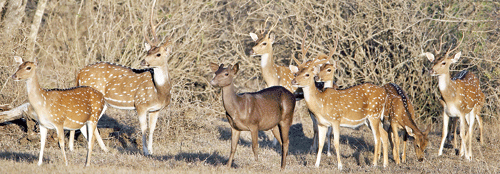Rare sight:‘Kalu Muwa’ spotted in Wilpattu
View(s):
The ‘Black Spotted Deer’ amidst a herd of spotted deer. Pic by Kithsiri Gunawardena
It was a single brief sighting of about 10 minutes at the Wilpattu National Park. But it was adequate for conservationist and photographer Kithsiri Gunawardena to be overjoyed.
For, what he saw was the ‘Black Spotted Deer’ or the ‘Kalu Muwa’ – a very rare melanistic Spotted Deer which he was able to photograph.
Here are Kithsiri’s notes:
“I received information from Mr. Seram who is an officer attached to the Department of Wildlife Conservation (DWC) of a black deer like animal that had been seen once or twice with a herd of Spotted Deer close to Pomparippu. No one was certain of the species of this strange animal as no one had seen such an animal in the wild. While some were of the opinion that it could be an immature sambhur, others wondered whether it is a hog deer. I had scheduled a field trip to Wilpattu from August 18-20 to engage in my study of leopards and other fauna and flora of the park and was quite keen to observe and photograph this strange animal.
“I spent three days at the park with Mr. D.M. Wasantha, a DWC guide, looking for this deer and was fortunate enough to have a single brief sighting one day of this uniquely coloured animal for about 10 minutes. Having examined the images, I was able to confirm that it is an extremely rare melanistic male Spotted Deer Axis axis.
“Melanism is the development of dark-coloured pigment, melanin, in the skin or its appendages and is the opposite of albinism, where the skin colour is white. While there have been a few records of albino mammals in the wild from Sri Lanka, melanistic animals such as the Black Leopard that was caught in an illegal snare in March 2009 from a village close to Deniyaya have been extremely rare.
“Spotted Deer are native to the Indian subcontinent. In Sri Lanka, they are found in the dry lowlands and are commonly seen in all the Dry Zone national parks. The upper parts of their skins are golden to rufous and are covered in white spots. The abdomen, rump, throat, insides of legs, ears and tail are all white. There are a few records of white coloured (albino) Spotted Deer in the past from our jungles, including the Wilpattu National Park where a water-hole is named as “sudu muwa wala” after an albino Spotted Deer that was seen in the early ’60s.
“Wilpattu is the largest and the oldest national park in the island with a unique cluster of breathtakingly beautiful water bodies which are referred to as Villus which support a multitude of species native to Sri Lanka. It is associated with the origins of the Sinhala race and holds so many places of archaeological importance. During my ongoing study, which began in 2011, I have so far recorded many species of fauna and flora including 208 species of birds, 31 species of mammals, 92 species of butterflies, 130 species of wild flowers and nine species of wild orchids from Wilpattu. My study of leopards has so far resulted in individually identifying and studying 76 different leopards. www.wilpattu.com
“This rare and unique specimen of the ‘Black Spotted Deer’ or ‘Kalu Muwa’ which has never been reported from any other park in the country is yet another reason for us to offer even greater protection to the Wilpattu National Park.”


